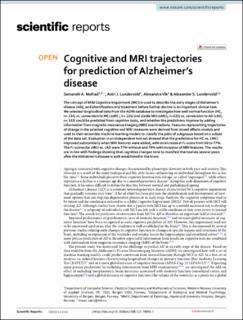| dc.contributor.author | Abolpour Mofrad, Samaneh | |
| dc.contributor.author | Lundervold, Astri Johansen | |
| dc.contributor.author | Vik, Alexandra | |
| dc.contributor.author | Lundervold, Alexander Selvikvåg | |
| dc.date.accessioned | 2021-03-22T07:40:30Z | |
| dc.date.available | 2021-03-22T07:40:30Z | |
| dc.date.created | 2021-01-22T13:21:28Z | |
| dc.date.issued | 2021 | |
| dc.identifier.citation | Mofrad, S. A., Lundervold, A. J., Vik, A., & Lundervold, A. S. (2021). Cognitive and MRI trajectories for prediction of Alzheimer’s disease. Scientific Reports, 11(1). | en_US |
| dc.identifier.issn | 2045-2322 | |
| dc.identifier.uri | https://hdl.handle.net/11250/2734631 | |
| dc.description.abstract | The concept of Mild Cognitive Impairment (MCI) is used to describe the early stages of Alzheimer’s disease (AD), and identification and treatment before further decline is an important clinical task. We selected longitudinal data from the ADNI database to investigate how well normal function (HC, n= 134) vs. conversion to MCI (cMCI, n= 134) and stable MCI (sMCI, n=333) vs. conversion to AD (cAD, n= 333) could be predicted from cognitive tests, and whether the predictions improve by adding information from magnetic resonance imaging (MRI) examinations. Features representing trajectories of change in the selected cognitive and MRI measures were derived from mixed effects models and used to train ensemble machine learning models to classify the pairs of subgroups based on a subset of the data set. Evaluation in an independent test set showed that the predictions for HC vs. cMCI improved substantially when MRI features were added, with an increase in F1-score from 60 to 77%. The F1-scores for sMCI vs. cAD were 77% without and 78% with inclusion of MRI features. The results are in-line with findings showing that cognitive changes tend to manifest themselves several years after the Alzheimer’s disease is well-established in the brain. | en_US |
| dc.language.iso | eng | en_US |
| dc.publisher | Nature | en_US |
| dc.rights | Navngivelse 4.0 Internasjonal | * |
| dc.rights.uri | http://creativecommons.org/licenses/by/4.0/deed.no | * |
| dc.title | Cognitive and MRI trajectories for prediction of Alzheimer’s disease | en_US |
| dc.type | Peer reviewed | en_US |
| dc.type | Journal article | en_US |
| dc.description.version | publishedVersion | en_US |
| dc.rights.holder | © The Author(s) 2021 | en_US |
| dc.subject.nsi | VDP::Datateknologi: 551 | en_US |
| dc.subject.nsi | VDP::Computer technology: 551 | en_US |
| dc.source.volume | 11 | en_US |
| dc.source.journal | Scientific Reports | en_US |
| dc.identifier.doi | 10.1038/s41598-020-78095-7 | |
| dc.identifier.cristin | 1877150 | |
| dc.relation.project | Bergens forskningsstiftelse: BFS2018TMT07 | en_US |
| cristin.ispublished | true | |
| cristin.fulltext | original | |
| cristin.qualitycode | 1 | |

